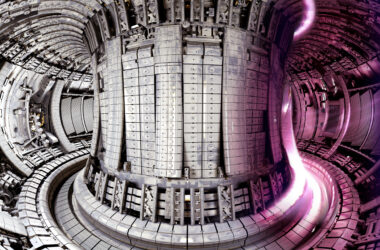Scientists at the Princeton Plasma Physics Laboratory (PPPL) have achieved a significant milestone in the quest for fusion energy.
By constructing a stellarator device called MUSE using permanent magnets and 3D-printed parts, they have demonstrated a potentially cost-effective and simplified approach to building future fusion reactors.
What is Nuclear Fusion?
Nuclear fusion powers stars, including our sun. Unlike nuclear fission, which splits atoms to generate energy, fusion merges light elements like hydrogen to release tremendous amounts of energy.
Fusion could provide a virtually limitless, clean energy source if harnessed on Earth. However, sustaining the extreme temperatures and pressures necessary for fusion reactions has proven challenging.
The Stellarator Design
Stellarators and tokamaks are devices designed to confine the hot plasma needed for fusion using magnetic fields. While tokamaks rely on electric currents within the plasma, stellarators use external, twisted magnetic coils to shape the field and keep the plasma stable.

This inherent stability makes stellarators suitable for continuous operation, but their complex magnet designs have traditionally been difficult and expensive to manufacture.
MUSE: A New Approach
The MUSE experiment at PPPL breaks the mould using permanent magnets instead of electromagnets to create the necessary magnetic fields. “Using permanent magnets is a completely new way to design stellarators,” explains graduate student Tony Qian, lead author of two papers detailing the project. “This technique allows us to test new plasma confinement ideas quickly and build new devices easily.”
Critical features of MUSE include:
- Off-the-shelf permanent magnets, similar to those used on refrigerators
- 3D-printed shell to hold the magnets in place
- Simplified, cost-effective construction compared to traditional stellarators
Michael Zarnstorff, a senior research physicist at PPPL and principal investigator of MUSE, realized the potential of permanent magnets in 2014. “I realized that even if they were situated alongside other magnets, rare-earth permanent magnets could generate and maintain the magnetic fields necessary to confine the plasma so fusion reactions can occur,” he reveals.
Theoretical Breakthrough: Quasisymmetry
In addition to its innovative design, MUSE exhibits a crucial theoretical property called quasisymmetry. Quasisymmetry ensures that the strength of the magnetic field is uniform around the device, leading to better plasma confinement and increasing the likelihood of fusion reactions.
“MUSE’s quasisymmetry optimization is at least 100 times better than any existing stellarator,” notes Zarnstorff. This breakthrough in quasisymmetry, combined with the simplified magnet design, positions MUSE as a potential game-changer in fusion research.
The PPPL team is now preparing a series of experiments to analyze MUSE’s performance and quasisymmetry properties further. These tests will provide crucial insights into the device’s ability to confine plasma and facilitate fusion reactions efficiently.
If successful, the MUSE project could pave the way for more affordable and accessible fusion power plants in the future. By demonstrating the viability of permanent magnets in stellarator designs, MUSE opens up new possibilities for simplifying and scaling up fusion technology.
However, it is essential to maintain a cautiously optimistic outlook. While MUSE represents a significant step forward, numerous technical and engineering challenges remain before fusion can become a practical, commercially viable energy source. Continued research, innovation, and investment will be necessary to bring the promise of fusion power to fruition.
TL;DR:
- Scientists at Princeton Plasma Physics Lab built a stellarator fusion reactor called MUSE using permanent magnets and 3D-printed parts.
- This simplified, cost-effective design could make future fusion reactors more accessible.
- MUSE also demonstrates unprecedented levels of quasisymmetry, a critical theoretical property for efficient plasma confinement.
- While a significant milestone, further research and development are needed to make fusion a viable energy source.








